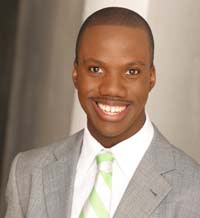 Dr. Shaun Harper is Director of the Center for the Study of Race and Equity in Education at the University of Pennsylvania.
Dr. Shaun Harper is Director of the Center for the Study of Race and Equity in Education at the University of Pennsylvania.In order to improve college completion rates among Black men, multiple stakeholders must reshape public policy on several fronts — from college sports to financial aid — in ways that create more favorable conditions for Black men to earn a degree.
So concludes a new report released Wednesday titled Men of Color: A Role for Policymakers in Improving the Status of Black Male Students in U.S. Higher Education.
The report — issued by the D.C.-based Institute for Higher Education Policy, or IHEP, and the University of Pennsylvania’s Center for the Study of Race in Education — comes at a time when many in scholarly circles have argued for the need to divorce race from public policy.
But IHEP officials and the authors of the report maintain that race cannot be ignored when data analyses consistently turn up gaps in degree attainment that follow racial lines.
“People want to look at [the situation] from a race-neutral perspective,” concedes Dr. Wendell Hall, deputy director at IHEP.
“But once you look into the data … if the data are telling you a story, it’s your obligation as an institution to follow up on what the data are telling you.”
To those who say college completion among Black men is a matter of individual responsibility, Hall says: “Individuals don’t’ create systems and policies.”
“While there is always [a need for] individual responsibility, the data are telling a story that Black men are not being attended to on college campuses,” and thus policy interventions are warranted, Hall said.
The report sounds a similar tone in its call for “greater involvement” by federal and state policymakers, high school counselors, as well as the NCAA, community-based organizations and other groups in various efforts to improve the status of Black undergraduate men.
The report acknowledges that Black men’s presence on campus has increased from 1980 to 2010, but laments that college graduation rates among Black men remain lackluster in comparison to the graduation rate of students overall.
As an example, it examines graduation rates by race at public universities in Michigan, where Black men, it says, completed baccalaureate degree programs “on average, at a rate nearly 17 percentage points lower than students overall.”
“Completion gaps between Black men and the overall student population are similar at public institutions across the United States and are of increasing concern for institutions interested in pursuing a diverse study body,” the report states.
To reverse the trend, the report makes several recommendations. They include:
- Increase federal and state financial aid for lower–income Black male students. “Many students who drop out of college do so because they cannot afford the cost,” the report states. It calls for “more aid and more initiatives” that enable lower-income students to attend college without having to work more than 20 hours per week off campus and for federal policymakers to increase or at least maintain Pell Grant spending because Black students are more likely to rely on Pell Grants than White students. “We’re not calling for special financial aid set aside for Black men,” said report co-author Dr. Shaun R. Harper, director of the Center for the Study of Race and Equity in Education at the University of Pennsylvania. “But we do recognize that even an increase in Pell Grants would help increase college [enrollment] for the men we’re discussing in this report.”
- Require more transparency and accountability in college sports. Citing the “documented gaps in graduation rates between Black and White male student–athletes,” the report says it is clear that “something must change.” Among other things, the report suggests that state policymakers and system-level leaders require colleges and universities to “collect, analyze and publish data” about the “overrepresentation” of Black men among revenue–generating college student–athletes. Institutions that show inequities year after year should be made to take action to reverse the trend, the report states. The report also says the NCAA should consider banning post-season play for sports teams that have racial inequalities in graduation rates, echoing a call by U.S. Secretary of Education Arne Duncan to make ineligible for post-season play and championship contests any team that fails to graduate at least 40 percent of its players. “The point we’re trying to make [about overrepresentation] is that institutions do a great job of finding Black males to play football and basketball,” said report co-author Dr. Frank Harris III, an education professor at San Diego State University, where he serves as co–director of the Minority Male Community College Collaborative. “They seem to be willing to go out of their way to provide those opportunities, but we do not see the same type of interest in Black men who don’t play sports.”
- Make state investments in education match spending on incarceration. “The issue of incarceration is complex and the overrepresentation of Black males in the criminal justice system cannot be simply attributed to funding decisions,” the report states. “However, the disproportionate amount of funding that is invested nationally toward incarcerating Black males in comparison to educating them is alarming. Thus, we recommend that state policymakers enact an investment strategy that matches taxpayer dollars spent on incarcerating 18– to 24–year–old Black men with race/gender–specific efforts that improve their pathways to and through college.” As an example, the report notes how taxpayers spent over $32,000 per year per inmate in 2010, an amount that rivals tuition at some colleges. “We’re saying give to K-12 schools and college prep programs that actually take boys off the street and gives the student programs that will show them the pathway to college,” Harper said.
- Address funding inequities that disadvantage public HBCUs: Noting that HBCUs outperform predominantly White institutions in graduating and preparing Black students for STEM careers and other high-need fields, such as the health field, the report calls for more equitable funding for HBCUs, which the report says have per-student expenditures that are among the lowest in the nation.















